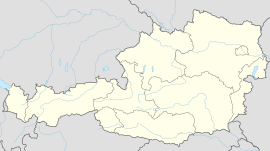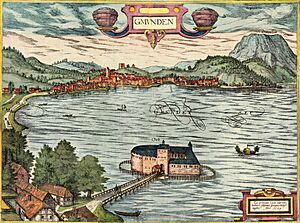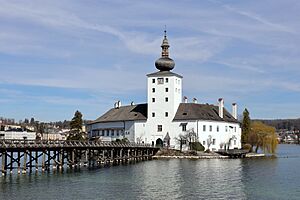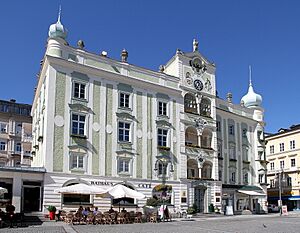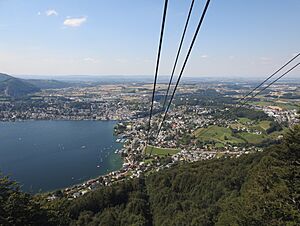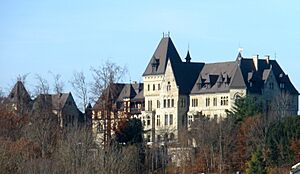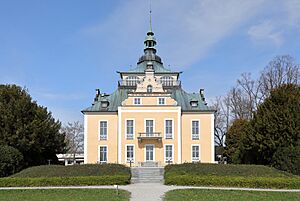Gmunden facts for kids
Quick facts for kids
Gmunden
|
||
|---|---|---|
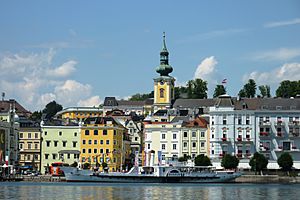
Lakeside
|
||
|
||
| Country | Austria | |
| State | Upper Austria | |
| District | Gmunden | |
| Area | ||
| • Total | 63.52 km2 (24.53 sq mi) | |
| Elevation | 425 m (1,394 ft) | |
| Time zone | UTC+1 (CET) | |
| • Summer (DST) | UTC+2 (CEST) | |
| Postal code |
4810
|
|
| Area code | 07612 | |
| Vehicle registration | GM | |
| Website | www.gmunden.ooe.gv.at | |
Gmunden is a town in Upper Austria, located in the Gmunden district. It is home to about 13,204 people (as of 2016). This charming town is known for its beautiful lakeside setting.
Contents
Exploring Gmunden's Geography
Gmunden covers an area of about 63.49 square kilometers (24.5 square miles). It sits at an average height of 425 meters (1,394 feet) above sea level. The town is right next to Traunsee, a lovely lake, and the Traun River.
Mountains and Natural Beauty
High mountains surround Gmunden, making for amazing views. Some of these tall peaks include the Traunstein (mountain), the Erlakogel, the Wilder Kogel, and the Höllengebirge. These mountains add to the town's stunning natural scenery.
How Gmunden is Organized
Gmunden is divided into several smaller areas, called boroughs. These include Gmunden, Gmunden-Ort, Schlagen, Traundorf, and Unterm Stein.
Towns Near Gmunden
Gmunden shares its borders with several other towns. These include Ohlsdorf, Gschwandt, Pinsdorf, Sankt Konrad, Altmünster, and Ebensee.
Understanding Gmunden's Population
In 2001, Gmunden had a population of 13,336 people. Most of the residents, about 88.4%, were Austrian citizens. A smaller number came from other European Union countries.
Diverse Backgrounds and Beliefs
About 10.2% of the people in Gmunden were from other countries. Many of these came from places like Bosnia and Herzegovina and the former FR Yugoslavia (now Serbia, Montenegro, Kosovo). There were also people from Turkey and Germany.
Most people in Gmunden, about 69.3%, are Roman Catholic. Other groups include Evangelicals (7.3%), Muslims (5.9%), and Eastern Orthodox Christians (3.3%). About 10.3% of the population does not follow a specific religion.
| Gmunden's population over time | |||||
|---|---|---|---|---|---|
| Year | Population | Year | Population | ||
| 1869 | c. 6,500 | 1951 | 12,894 | ||
| 1880 | 6,857 | 1961 | 12,518 | ||
| 1890 | 7,521 | 1971 | 12,331 | ||
| 1900 | 8,451 | 1981 | 12,653 | ||
| 1910 | 8,451 | 1991 | 13,133 | ||
| 1923 | 9,633 | 2001 | 13,184 | ||
| 1934 | 9,838 | 2011 | 13,086 | ||
| 1939 | 10,792 | 2016 | 13,204 | ||
A Look at Gmunden's History
Gmunden has a long and interesting history. As far back as 1000 BCE, the Illyrians were mining salt in this area. A settlement already existed here by the fifth century CE.
From Fort to Town
By 1186, Gmunden was a strong, walled town. It got its first church around the year 1300. In 1278, Gmunden officially became a town.
Historical Events
On November 14, 1626, a large army of rebellious farmers was defeated in Gmunden. This happened during a peasant rebellion in Upper Austria. General Pappenheim led the army that stopped the rebellion. The farmers who died were buried in nearby Pinsdorf. You can still see a memorial there called the Bauernhügel, which honors them.
Gmunden also played a role in wars. In the 17th century, it provided ships for Austria's navy. During World War I, the town helped wounded soldiers by providing hospitals. During World War II, a special home for mothers was located here.
A Place for Health and Salt
In later years, Gmunden became a popular place for people to visit for their health and for summer holidays. It offered different kinds of baths and treatments. It was also a very important center for the salt industry in the Salzkammergut region.
Discovering Gmunden's Main Sights
Gmunden has many interesting places to visit and things to see.
Castles and Pottery
One famous spot is Schloss Ort, a beautiful castle. You can also visit a ceramic factory that makes special pottery called Gmundner Keramik. The town hall is also a popular place for tourists to see.
Education in Gmunden
Gmunden offers various schools for young people. There are four kindergartens for younger children. For elementary education, there are four elementary schools. The town also has three Hauptschulen, which are secondary schools. For high school, students can attend BG/BRG Gmunden, BRG Schloss Traunsee, or Gymnasium Ort.
Famous People from Gmunden
Many interesting people have connections to Gmunden:
- Johannes von Gmunden (around 1380–1442), an expert in astronomy and math.
- Caspar Erasmus Duftschmid (1767–1821), a naturalist and doctor.
- Matthias von Schönerer (1807–1881), an engineer who helped build railways.
- Friedrich Theodor Vischer (1807–1887), a writer of novels, poems, and plays.
- Carl Rahl (1812–1865), a painter.
- Ludwig Bemelmans (1898–1962), an Austrian-American writer who grew up here.
- Thomas Bernhard (1931–1989), a famous Austrian novelist and playwright.
- Christoph Ransmayr (born 1954), an Austrian writer who grew up in Gmunden.
- Andreas Berger (born 1961), a former Austrian sprinter.
- Gabi Burgstaller (born 1963), an Austrian politician who went to high school here.
- Conchita Wurst (born 1988), a drag queen and winner of the Eurovision Song Contest 2014.
|
See also
 In Spanish: Gmunden para niños
In Spanish: Gmunden para niños



